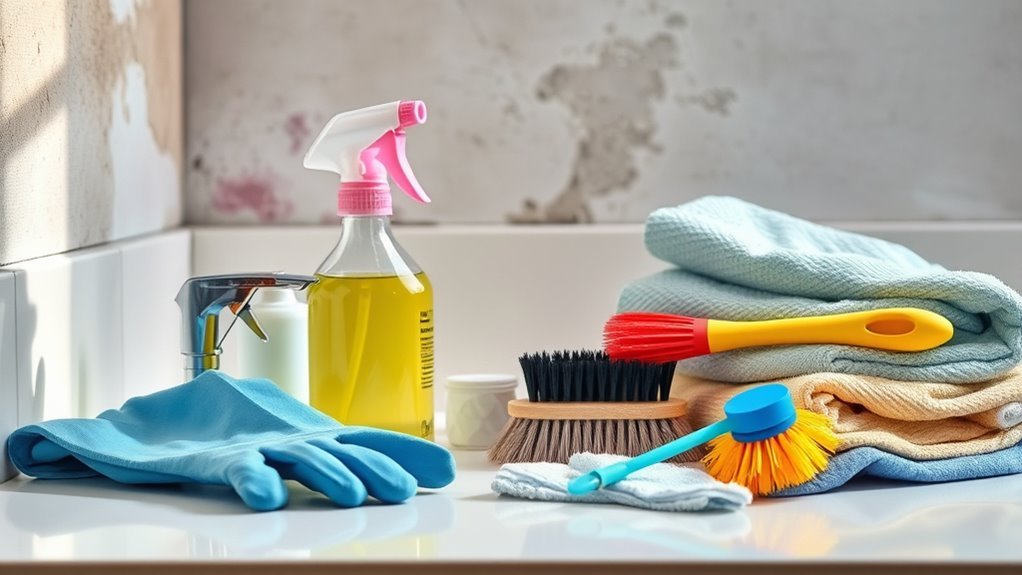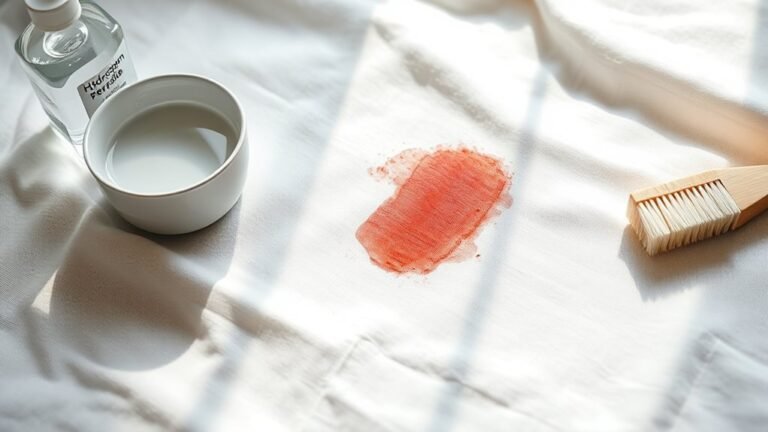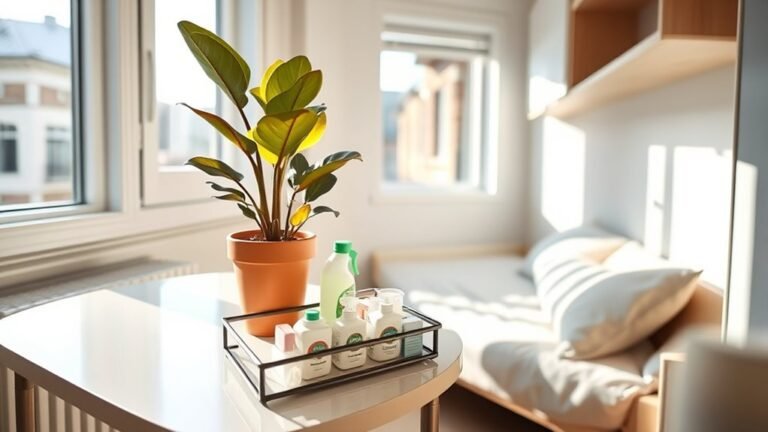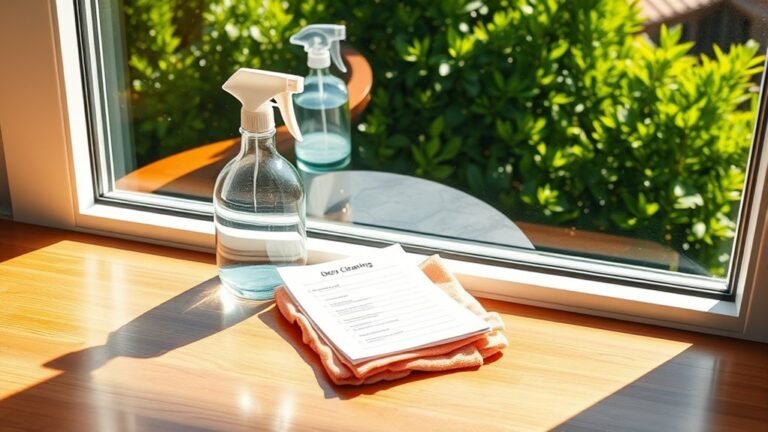Essential Tools for Cleaning Mold
To clean mold safely and effectively, you’ll need protective gear like an N95 mask, gloves, coveralls, and goggles. Use appropriate disinfectants or homemade solutions based on mold severity and surface type. Equip yourself with scrubbing brushes, HEPA vacuum cleaners, and plastic sheeting for containment. Dehumidifiers and air purifiers control moisture and airborne spores, while moisture meters help detect hidden dampness. Combining these tools guarantees thorough remediation and long-term prevention. Understanding each tool’s role will help you tackle mold with confidence.
Protective Gear for Mold Removal
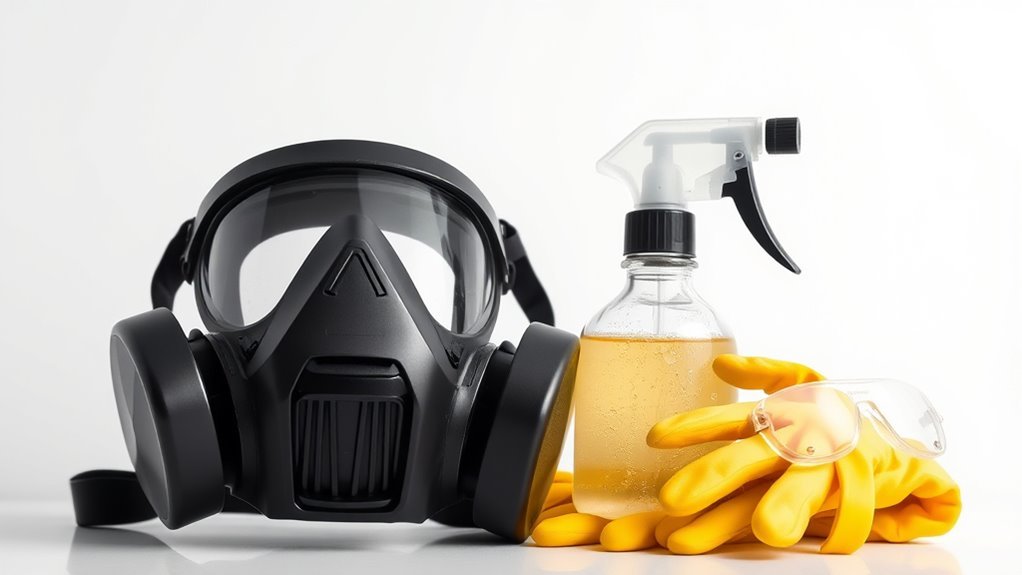
Before you begin mold removal, it’s crucial to equip yourself with the proper protective gear to minimize health risks. Respiratory protection is critical; you should use an N95 respirator or higher-rated mask to prevent inhaling mold spores, which can cause respiratory issues. Protective clothing is equally important to shield your skin and prevent contamination. Use disposable coveralls with elastic cuffs to avoid spores settling on your clothes. Gloves made from nitrile or rubber provide a barrier against mold and cleaning agents. Also, consider goggles to protect your eyes from irritants. Ensuring a secure fit for all gear maximizes effectiveness. By prioritizing respiratory protection and protective clothing, you maintain your health freedom while effectively managing mold hazards during removal.
Cleaning Solutions and Disinfectants
When tackling mold, choosing the right cleaning solution is critical for effective removal and prevention. You’ll need to understand the differences between common disinfectants like bleach, hydrogen peroxide, and specialized commercial products. Additionally, weighing the benefits and limitations of homemade mixtures versus professional-grade cleaners will help you achieve ideal results safely.
Types of Cleaning Solutions
Although mold removal requires thorough cleaning, choosing the right type of cleaning solution is essential for effective remediation. You’ll want to select solutions that not only eliminate mold but also prevent its return. Eco friendly cleaners are a smart choice, as they minimize environmental impact while effectively breaking down mold spores. When treating surfaces, applying mold resistant paints afterward can provide a durable barrier against future growth. Avoid harsh chemicals that could damage materials or compromise indoor air quality. Instead, opt for solutions specifically formulated for mold remediation, ensuring compatibility with the surfaces you’re treating. By carefully selecting appropriate cleaning agents and protective coatings, you maintain your freedom to create a safe, mold-free environment without sacrificing health or sustainability.
Effective Disinfectants for Mold
Several disinfectants have proven effective against mold, each with specific applications and limitations you should understand. For mold removal, solutions containing sodium hypochlorite (bleach) are widely used due to their strong antimicrobial properties, but they require thorough surface preparation to guarantee porous materials don’t retain moisture, which can encourage regrowth. Hydrogen peroxide is another effective disinfectant, offering oxidative action without harmful fumes, suitable for non-porous surfaces. Quaternary ammonium compounds provide broad-spectrum efficacy and are favored in commercial settings, yet they demand proper dilution and contact time. Before applying any disinfectant, you must complete surface preparation by cleaning debris and mold residues to maximize contact efficiency. Selecting the right disinfectant based on your surface type and mold severity guarantees effective mold removal while minimizing health risks and environmental impact.
Homemade vs. Commercial Products
Deciding between homemade and commercial cleaning solutions for mold removal depends on factors like mold severity, surface type, and safety considerations. Homemade remedies, such as diluted vinegar or baking soda solutions, offer a low-cost, accessible option for minor mold issues on non-porous surfaces. They’re generally safer, minimizing exposure to harsh chemicals, but their effectiveness may be limited against extensive mold growth. Commercial products, formulated with potent biocides and fungicides, provide higher commercial effectiveness, especially for stubborn or widespread mold infestations. However, they require careful handling and proper ventilation to avoid health risks. To maintain your freedom in choosing a cleaning approach, assess the mold’s extent and surface compatibility, then select either a precise homemade remedy or a targeted commercial disinfectant, balancing safety and efficacy.
Scrubbing Brushes and Sponges
Scrubbing brushes and sponges play an essential role in effectively removing mold from surfaces by reaching into crevices and agitating stubborn growth. When selecting these tools, consider brush materials carefully—nylon bristles offer durability and flexibility, while natural fibers might be less resilient against harsh cleaning agents. Your cleaning techniques should maximize contact with mold colonies without damaging surfaces; firm, circular motions help dislodge spores efficiently. Sponges with abrasive sides are ideal for smooth surfaces, but avoid overly porous types that can harbor mold themselves. Always designate brushes and sponges exclusively for mold cleanup to prevent cross-contamination. Using the right combination of tool material and method empowers you to clean thoroughly, maintaining control and freedom over your mold remediation process.
HEPA Vacuum Cleaners
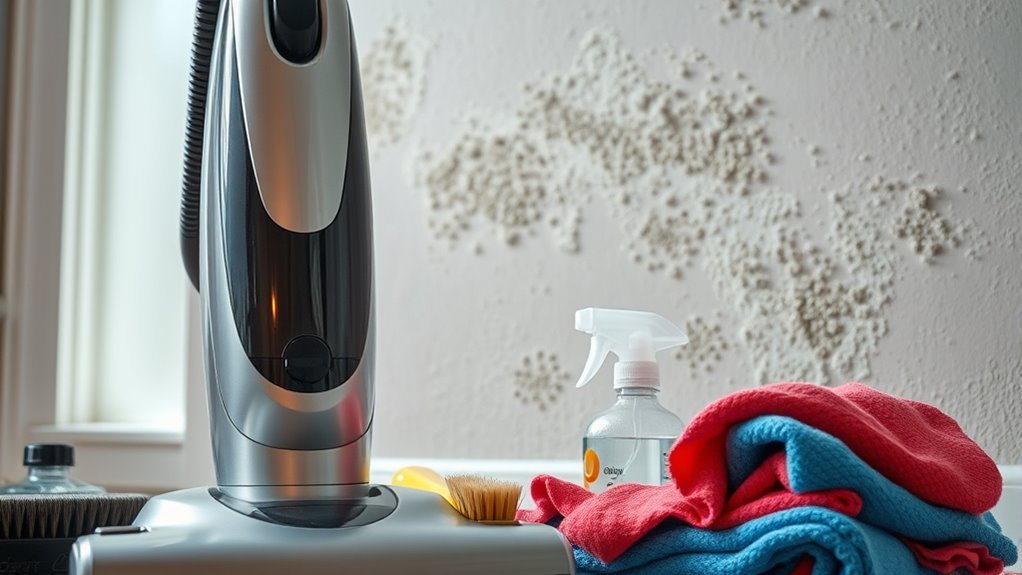
One key tool for controlling airborne mold spores during cleanup is a HEPA vacuum cleaner, which uses a high-efficiency particulate air filter to capture particles as small as 0.3 microns with 99.97% efficiency. When you use a HEPA vacuum, you’re effectively reducing spore circulation, essential for preventing mold spread. Make sure your vacuum is equipped with genuine HEPA filters, as substandard ones won’t trap spores adequately. Vacuum maintenance is equally important; regularly inspect and replace filters to sustain filtration performance and prevent clogging. Clean the vacuum’s seals and compartments to avoid contamination buildup. Using a HEPA vacuum correctly grants you the freedom to clean mold-affected areas without dispersing spores, maintaining indoor air quality and safeguarding your environment with precision and reliability.
Dehumidifiers and Air Purifiers
You’ll want to use a dehumidifier to reduce moisture levels, which directly inhibits mold growth. Pairing this with an air purifier that features HEPA and activated carbon filters helps capture airborne mold spores and volatile organic compounds. Together, these devices notably improve indoor air quality and support effective mold remediation.
Benefits of Dehumidifiers
Although controlling humidity alone won’t eliminate mold, using a dehumidifier greatly reduces the moisture levels that mold spores need to thrive. By selecting the appropriate dehumidifier type—such as refrigerant, desiccant, or whole-house models—you can optimize humidity control tailored to your space. These devices maintain relative humidity below 50%, creating an environment unfavorable for mold growth. Effective humidity control not only inhibits mold but also protects structural materials and improves indoor air quality. When you use a dehumidifier consistently, you gain freedom from persistent dampness and potential health risks associated with mold exposure. Understanding the specific functionality and capacity of each dehumidifier type guarantees you choose the right tool, empowering you to maintain a dry, mold-resistant environment efficiently and reliably.
Air Purifier Features
While dehumidifiers reduce moisture, air purifiers target airborne mold spores and allergens to improve indoor air quality. Understanding air purifier types helps you select the right device to effectively capture microscopic particles and maintain a healthy environment. Key features like HEPA filters, activated carbon, and UV-C light enhance mold spore removal and air quality.
| Feature | Purpose |
|---|---|
| HEPA Filter | Captures 99.97% of particles ≥0.3 microns |
| Activated Carbon | Absorbs odors and volatile organic compounds |
| UV-C Light | Destroys mold spores and bacteria |
| CADR Rating | Measures purification speed and efficiency |
| Noise Level | Affects comfort during operation |
Choose an air purifier that balances these features to achieve mold-free, breathable air effortlessly.
Improving Indoor Air Quality
Alongside air purifiers, dehumidifiers play an essential role in improving indoor air quality by reducing excess moisture that mold needs to grow. You’ll want to maintain relative humidity levels between 30-50% to inhibit mold proliferation effectively. Using dehumidifiers in conjunction with well-designed ventilation systems enhances air circulation, preventing stagnant, damp environments. While indoor plants can improve air quality by absorbing certain pollutants, they may increase humidity if overwatered, so monitor their impact carefully. Air purifiers equipped with HEPA and activated carbon filters capture mold spores and volatile organic compounds, further cleaning the air. By integrating these tools, you empower yourself to create a healthier, mold-resistant environment without sacrificing your freedom to customize living spaces. Proper maintenance and strategic placement are key to maximizing their effectiveness.
Plastic Sheeting and Tape
Plastic sheeting and tape are fundamental for containing mold during cleanup, preventing its spores from spreading to unaffected areas. When you’re tackling mold, you must establish an effective mold containment barrier by securely sealing off work zones with durable plastic sheeting. This limits airborne spores, preserving the integrity of your indoor environment. Use high-quality tape to fasten the plastic to walls, floors, and ceilings, ensuring no gaps remain. Besides containment, plastic sheeting provides essential surface protection by covering furniture, vents, and flooring, preventing contamination and facilitating easier cleanup. Selecting thick, tear-resistant sheeting enhances durability during prolonged projects. Mastering the proper installation of plastic sheeting and tape empowers you to maintain strict control over mold spread, ensuring a safer, freer space throughout the remediation process.
Moisture Meters for Detection
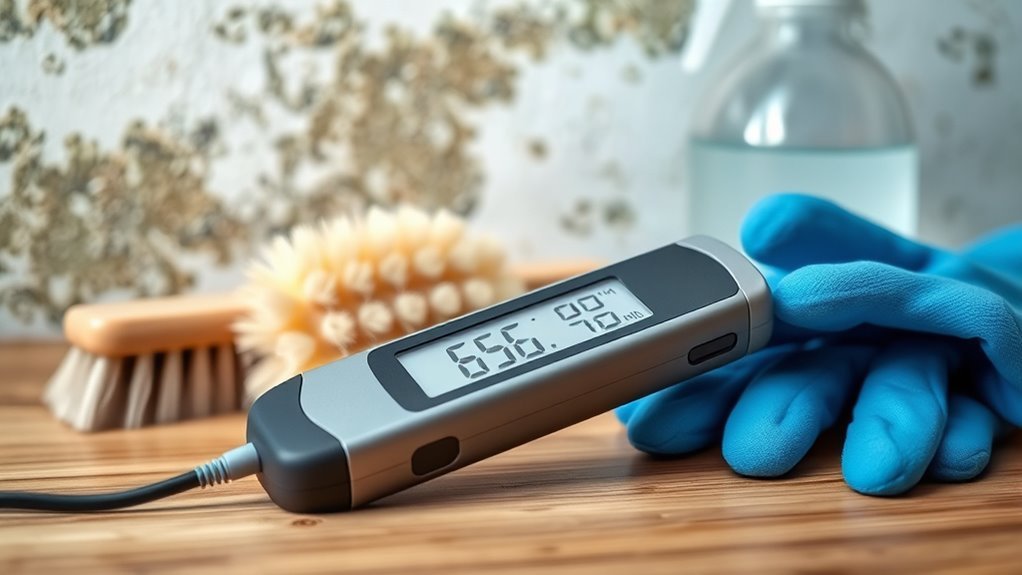
After securing the work area with plastic sheeting and tape, the next step is accurately identifying moisture levels that contribute to mold growth. Moisture meters are essential for this task, employing advanced moisture detection techniques to pinpoint damp areas within materials like wood, drywall, and concrete. By measuring electrical resistance or capacitance, these devices provide precise moisture content readings, enabling you to identify hidden water intrusion sources. Understanding these moisture levels informs effective humidity control methods, preventing mold from reoccurring. Using a moisture meter allows you to assess whether remediation efforts have successfully dried affected areas, ensuring lasting results. Incorporating moisture detection into your mold cleanup strategy grants you the freedom to maintain a safe, dry environment, minimizing future mold risks through informed, data-driven decisions.
Frequently Asked Questions
How Long Does Mold Take to Grow After Water Damage?
Like the swift rise of a shadow at dusk, mold growth timeline after water damage effects is quick and relentless. You can expect mold to begin developing within 24 to 48 hours once moisture invades your space. This rapid onset demands immediate action to prevent structural and health issues. Understanding this timeframe empowers you to act swiftly, preserving your freedom from prolonged contamination and costly repairs.
Can Mold Cause Health Issues in Pets?
Yes, mold exposure can cause health issues in pets. Just like in humans, inhaling or coming into contact with mold spores may lead to respiratory problems, allergic reactions, or skin irritation in your pets. It’s essential to monitor your pet’s health closely if you suspect mold in your environment, as untreated mold exposure can worsen their condition. Protecting pet health means addressing mold problems promptly to guarantee their safety and comfort.
Is It Safe to Paint Over Moldy Surfaces?
Is it wise to paint over moldy surfaces without proper preparation? You shouldn’t, as painting over mold only masks the problem and can worsen it. Effective mold prevention techniques involve thoroughly cleaning and treating the area first to eliminate spores. When considering painting, guarantee the surface is dry and mold-free, using mold-resistant primers and paints. This approach safeguards your space while respecting your freedom to maintain a healthy environment.
How Often Should Mold Inspection Be Done in Homes?
You should schedule mold inspection based on mold growth frequency and home inspection intervals. Typically, inspecting your home every 6 to 12 months is advisable, especially in areas prone to moisture. If you’ve experienced water damage or high humidity, more frequent checks are necessary to catch mold early. Regular inspections help maintain a safe environment and prevent extensive remediation, giving you the freedom to enjoy your space without health concerns.
Are There Natural Alternatives to Commercial Mold Cleaners?
Yes, you can use natural alternatives to commercial mold cleaners. A vinegar solution is effective because its acidity kills most mold species without harsh chemicals. You can spray undiluted white vinegar directly on moldy areas and let it sit for an hour before wiping. Hydrogen peroxide is another option; a 3% solution works well to eliminate mold by breaking down its cellular structure. Both options offer a safer, eco-friendly approach.
